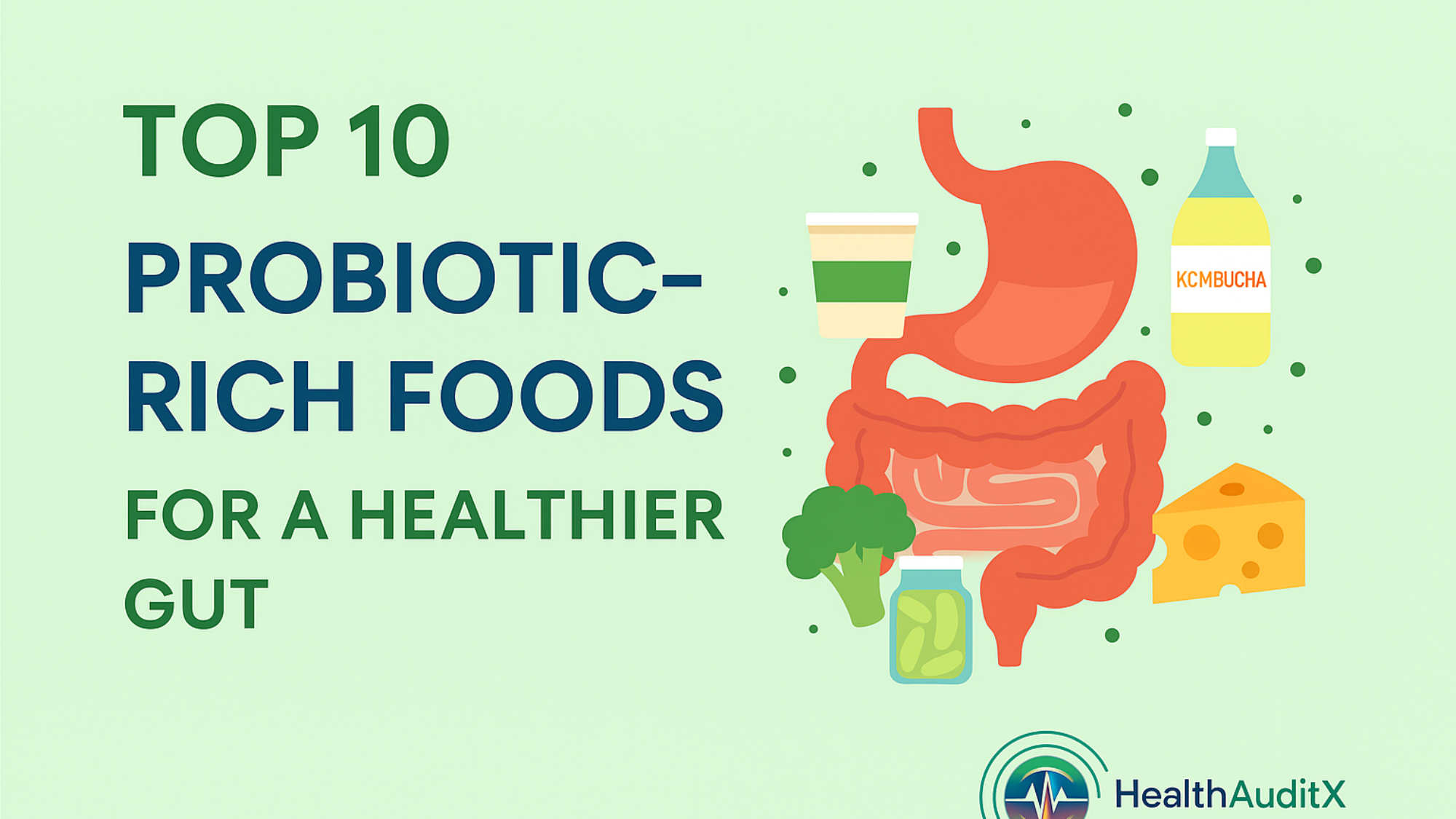🧠 Introduction: Your gut is home to trillions of bacteria that influence not only digestion but also immunity, mental health, and even your skin. In recent years, science has uncovered just how crucial gut health is to your overall well-being, and one of the best ways to support it is by eating probiotic-rich foods. Probiotics are live microorganisms that offer numerous health benefits when consumed in adequate amounts. While supplements are available, the best (and most natural) sources of probiotics come from food.
In this guide, we’ll explore the top 10 probiotic-rich foods you can add to your daily diet to improve gut health, digestion, and more.
🥛 1. Yogurt
✅ Why it’s good: Yogurt is probably the most well-known probiotic food. It’s made by fermenting milk with live bacteria, primarily Lactobacillus and Bifidobacterium.
💡 Health benefits:
- Improves lactose digestion
- Enhances immune function
- Reduces symptoms of irritable bowel syndrome (IBS)
📝 Tips: Choose plain, unsweetened yogurt with labels that say “live and active cultures.” Flavored yogurts often contain high amounts of sugar that may counteract the benefits.
🥤 2. Kefir
✅ Why it’s good: Kefir is a fermented milk drink with a thinner consistency than yogurt. It contains a broader range of probiotics—up to 30 different strains.
💡 Health benefits:
- Rich in calcium and vitamin B12
- Contains powerful antibacterial properties
- Supports bone and digestive health
📝 Tips: Start with small amounts, especially if you’re not used to fermented foods. It has a tangy, slightly sour taste that can take some getting used to.
🥬 3. Sauerkraut
✅ Why it’s good: Sauerkraut is made by fermenting cabbage in brine. It’s a traditional staple in many European diets and is packed with not only probiotics but also fiber and vitamins.
💡 Health benefits:
- Supports digestion
- Boosts the immune system
- Rich in antioxidants like lutein and zeaxanthin
📝 Tips: Look for unpasteurized versions in the refrigerated section—pasteurization kills live bacteria.
🌶️ 4. Kimchi
✅ Why it’s good: Kimchi is a spicy, fermented Korean dish made from cabbage, radish, and a variety of seasonings. It’s not only flavorful but also a probiotic powerhouse.
💡 Health benefits:
- It may help lower cholesterol
- Supports metabolic health
- Offers anti-inflammatory benefits
📝 Tips: Add kimchi to rice dishes, sandwiches, or soups. It pairs well with both Asian and Western meals.
🍜 5. Miso
✅ Why it’s good: Miso is a traditional Japanese paste made by fermenting soybeans with salt and koji (a type of fungus). It’s commonly used in soups and sauces.
💡 Health benefits:
- High in essential minerals and B vitamins
- Supports digestion
- May reduce the risk of some cancers
📝 Tips: Add miso to warm (not boiling) water to preserve its live cultures.
🍞 6. Tempeh
✅ Why it’s good: Tempeh is a fermented soybean cake that originates from Indonesia. It’s firm, nutty in flavor, and rich in protein and probiotics.
💡 Health benefits:
- Promotes gut health
- Improves cholesterol levels
- High in protein and iron
📝 Tips: Tempeh can be grilled, stir-fried, or added to salads and sandwiches as a meat alternative.
🥒 7. Pickles (Fermented Cucumbers)
✅ Why it’s good: Naturally fermented pickles (not vinegar-brined) are a tasty and crunchy way to get more probiotics.
💡 Health benefits:
- Aids digestion
- Supports gut flora balance
- Low in calories, making it a guilt-free snack
📝 Tips: Make sure to check the label for “naturally fermented” or make your own at home.
🧋 8. Kombucha
✅ Why it’s good: Kombucha is a fizzy, fermented tea made with a SCOBY (symbiotic culture of bacteria and yeast). It’s grown popular for its unique taste and gut-boosting qualities.
💡 Health benefits:
- Aids digestion
- Detoxifies the liver
- May reduce inflammation
📝 Tips: Watch the sugar content in commercial kombucha and start with small servings if you’re new to it.
🍛 9. Natto
✅ Why it’s good: Natto is another Japanese staple made from fermented soybeans. It has a strong smell and sticky texture, but it’s incredibly nutritious.
💡 Health benefits:
- High in Bacillus subtilis, a potent probiotic
- Contains nattokinase, which may improve heart health
- Excellent source of vitamin K2
📝 Tips: If the taste is too strong, mix natto with rice or eggs to tone it down.
🧀 10. Raw Cheese
✅ Why it’s good: Some raw, unpasteurized cheeses—especially those made from sheep or goat milk—contain beneficial probiotics.
💡 Health benefits:
- Supports bone health
- Offers healthy fats
- Provides gut-friendly bacteria
📝 Tips: Look for cheese labeled “made from raw milk.” Goat cheese, Gouda, and cheddar are good options.
🧃 How to Add Probiotic Foods to Your Diet
You don’t need to eat all 10 foods daily—start small and rotate through a few favorites. Here’s a sample daily plan:
- 🥣 Breakfast: Yogurt with berries and honey
- 🥗 Lunch: Salad with kimchi or sauerkraut
- 🥒 Snack: Pickles or kombucha
- 🍽️ Dinner: Stir-fried tempeh or miso soup
Also, try combining probiotics with prebiotics (fibers that feed good bacteria), such as garlic, onions, bananas, and asparagus.
✅ Final Thoughts
Probiotic-rich foods are a natural and effective way to improve your gut health. When consumed regularly, they can lead to better digestion, a stronger immune system, and even improved mood. The key is consistency and variety.
If you’re just starting, try adding one or two probiotic foods to your meals each day and build from there. Listen to your body and see how it responds.
Want to reboot your gut in just 7 days? 👉 Download our Free 7-Day Gut Reset Meal Plan
📌 Also Read:
- Heart Check Up: Why It’s a Must, Not a Maybe in Today’s Fast-Paced World
- Symptom Analysis: The Smarter Way to Understand Your Health
- How Walking Faster Can Lower Your Risk of Abnormal Heart Rhythms: A Study-Backed Insight?
Stay healthy. Stay balanced. Stay vibrant with HealthAuditX.


Add a Comment